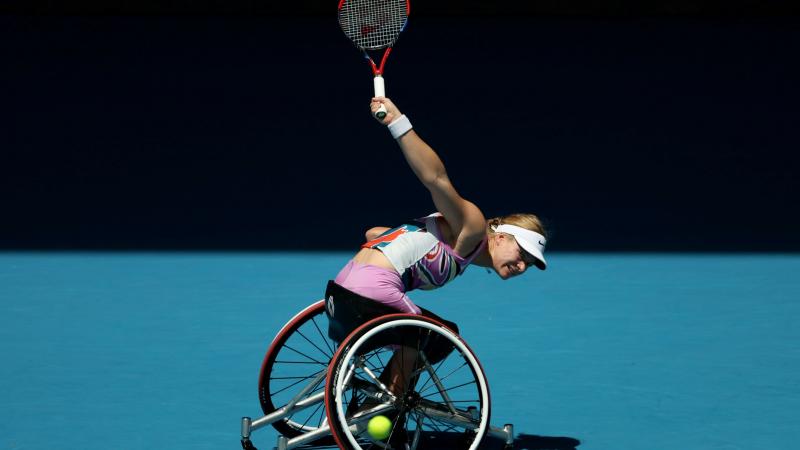Table of contents
Introduction
Overview of Wheelchair Tennis in the Paralympics
Wheelchair tennis is a dynamic and competitive sport that has carved out a significant place within the Paralympic movement. Since its inception, the sport has not only provided a platform for athletes with physical disabilities to showcase their talents but has also played a vital role in the broader development and visibility of Paralympic sports. As one of the fastest-growing wheelchair sports globally, wheelchair tennis embodies the spirit of inclusion, perseverance, and excellence, making it a cornerstone of the Paralympic Games.
The sport’s structure, which closely mirrors the able-bodied version of tennis, offers a unique blend of athleticism and skill, allowing for high levels of competition and entertainment. Athletes in wheelchair tennis compete in various categories, including men’s, women’s, and quads, across both singles and doubles formats. The sport has been integrated into major tennis tournaments, including the Grand Slams, further cementing its status in the global sports arena.

History and Evolution
The history of wheelchair tennis is rooted in the innovation and determination of athletes who refused to let physical limitations define their abilities. The sport was officially founded in 1976 by Brad Parks, a former US freestyle skier who, after an accident that left him paralyzed, sought to adapt tennis for players in wheelchairs. Parks’ pioneering efforts laid the foundation for what would become a worldwide phenomenon.
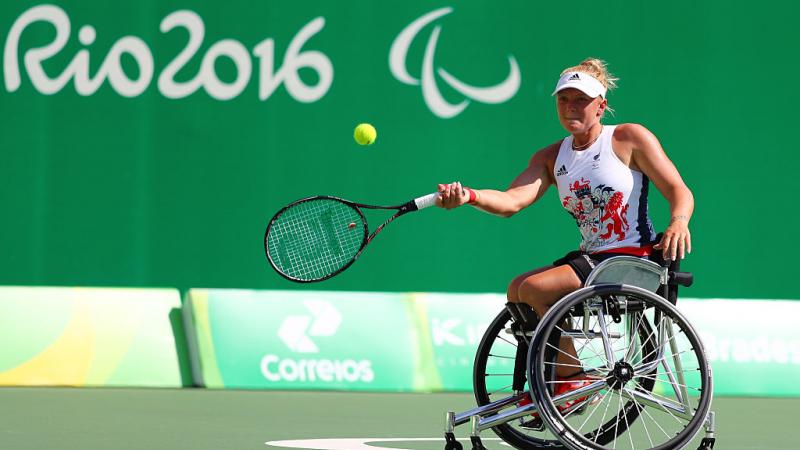
In the early days, wheelchair tennis was largely confined to the United States, where Parks and other early adopters worked tirelessly to promote the sport. However, the 1980s marked a turning point in its development, as France became the first country in Europe to establish a dedicated wheelchair tennis program. This initiative sparked interest across the continent and led to the sport’s rapid expansion in Europe and beyond.
The sport’s inclusion in the Paralympics was a significant milestone in its history. Wheelchair tennis made its debut as a demonstration sport at the Seoul 1988 Paralympic Games and was officially included in the Paralympic program at the Barcelona 1992 Games. Since then, it has grown in popularity and prestige, with athletes from around the world competing at the highest levels.
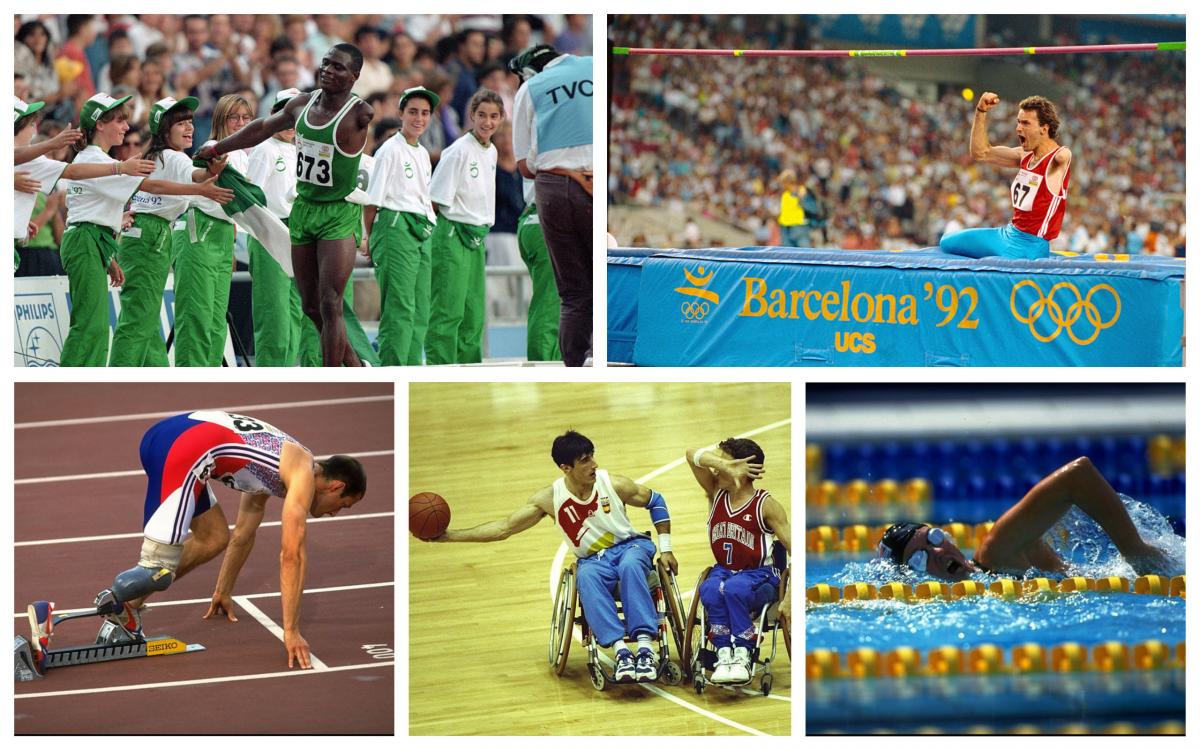
Importance of the Sport in the Paralympic Movement
Wheelchair tennis holds a special place within the Paralympic movement, not only because of its competitive nature but also because of its symbolic importance. The sport exemplifies the core values of the Paralympic Games: determination, courage, equality, and inspiration. By providing a platform for athletes with physical disabilities to compete on equal terms, wheelchair tennis challenges societal perceptions of disability and highlights the potential of adaptive sports to transform lives.
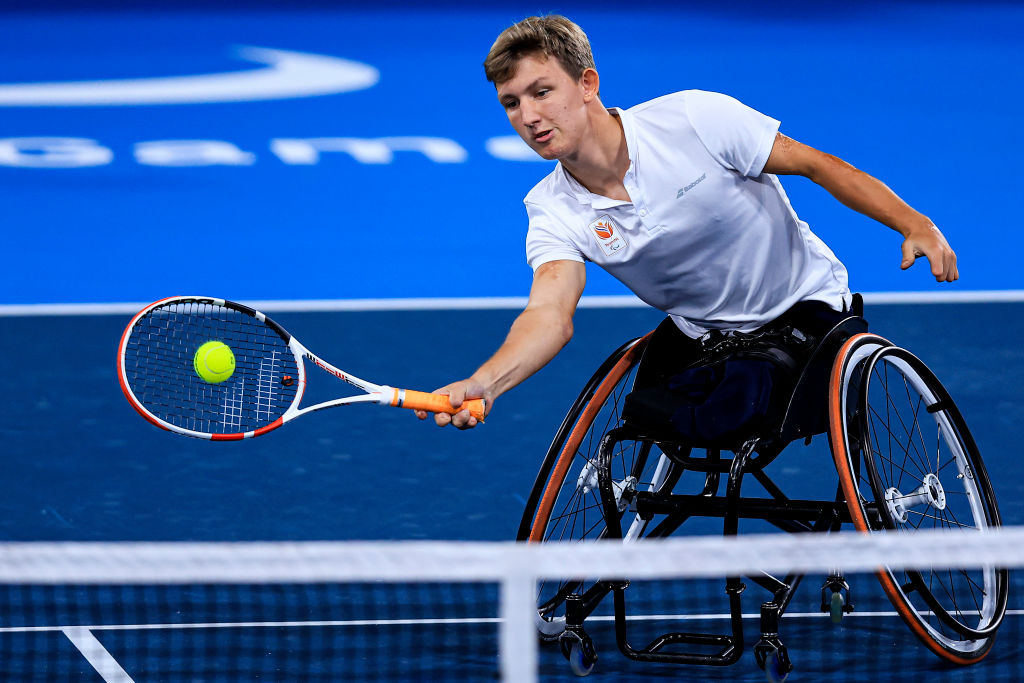
The sport’s growing popularity and integration into mainstream tennis tournaments have also contributed to the broader acceptance and visibility of Paralympic sports. Wheelchair tennis players regularly compete in prestigious events such as the Australian Open, Roland Garros, Wimbledon, and the US Open, often alongside able-bodied athletes. This exposure has helped to elevate the profile of Paralympic athletes and has played a key role in the ongoing efforts to promote inclusivity in sports.
Moreover, wheelchair tennis has inspired a new generation of athletes, demonstrating that physical limitations do not have to be a barrier to success. The sport’s continued evolution and the achievements of its athletes serve as a powerful testament to the resilience and determination that define the Paralympic movement.
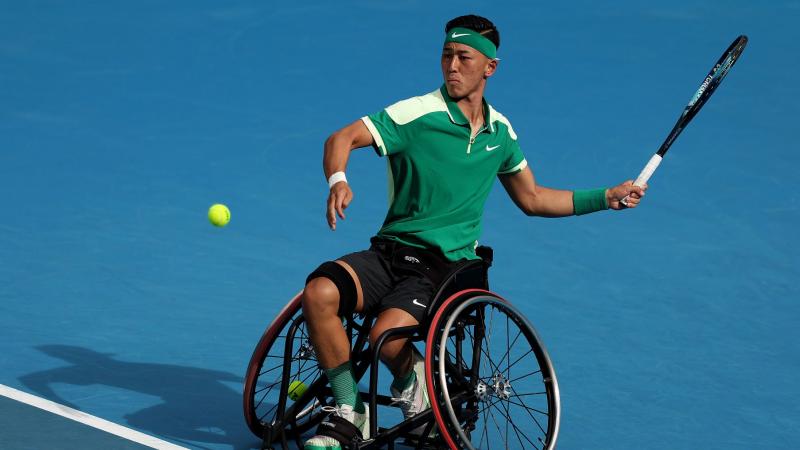
Key Figures and Milestones
The evolution of wheelchair tennis has been shaped by the achievements of remarkable athletes who have not only dominated the sport but have also become ambassadors for the Paralympic movement. These key figures have set new standards of excellence, breaking records and pushing the boundaries of what is possible in wheelchair sports.
One of the most prominent figures in wheelchair tennis is Alfie Hewett of Great Britain, who currently holds the world number one ranking in both singles and doubles. Hewett has amassed an impressive 30 Grand Slam titles, including 9 singles and 21 doubles titles. His success on the court has made him a role model for aspiring athletes and a key figure in the global promotion of wheelchair tennis.
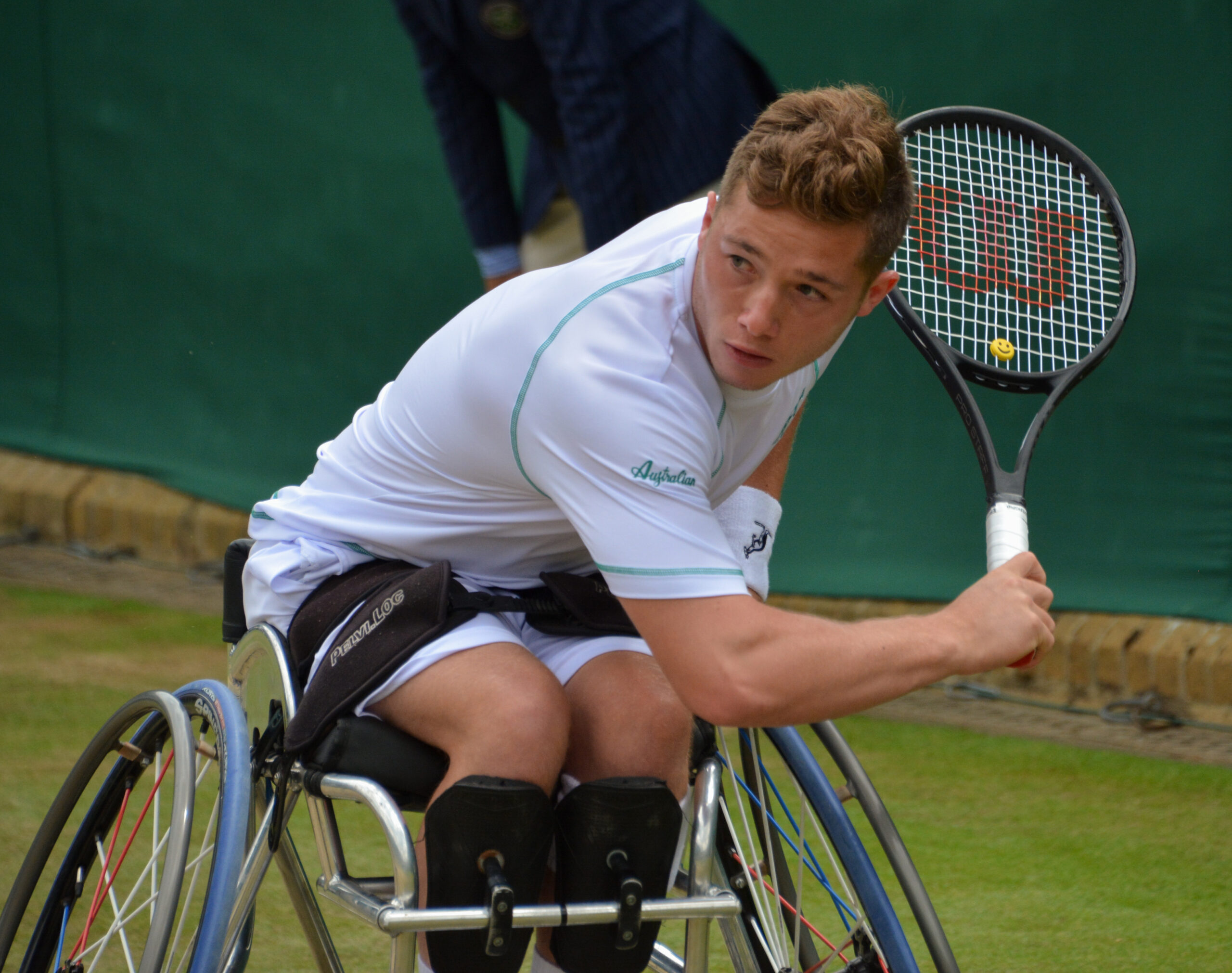
Another legendary player is Shingo Kunieda of Japan, who is widely regarded as one of the greatest wheelchair tennis players of all time. Kunieda’s career is highlighted by his achievement of a lifetime Golden Slam, which includes winning all four Grand Slam titles and the Paralympic gold medal in a single year. With a total of 50 titles, including three Paralympic gold medals in singles and one in doubles, Kunieda has left an indelible mark on the sport.
Esther Vergeer of the Netherlands is another iconic figure in wheelchair tennis, known for her unparalleled dominance in the women’s division. Vergeer holds the record for the most consecutive wheelchair singles matches won, a staggering achievement that underscores her exceptional skill and consistency. Her four Paralympic gold medals further cement her legacy as one of the greatest athletes in the history of the sport.
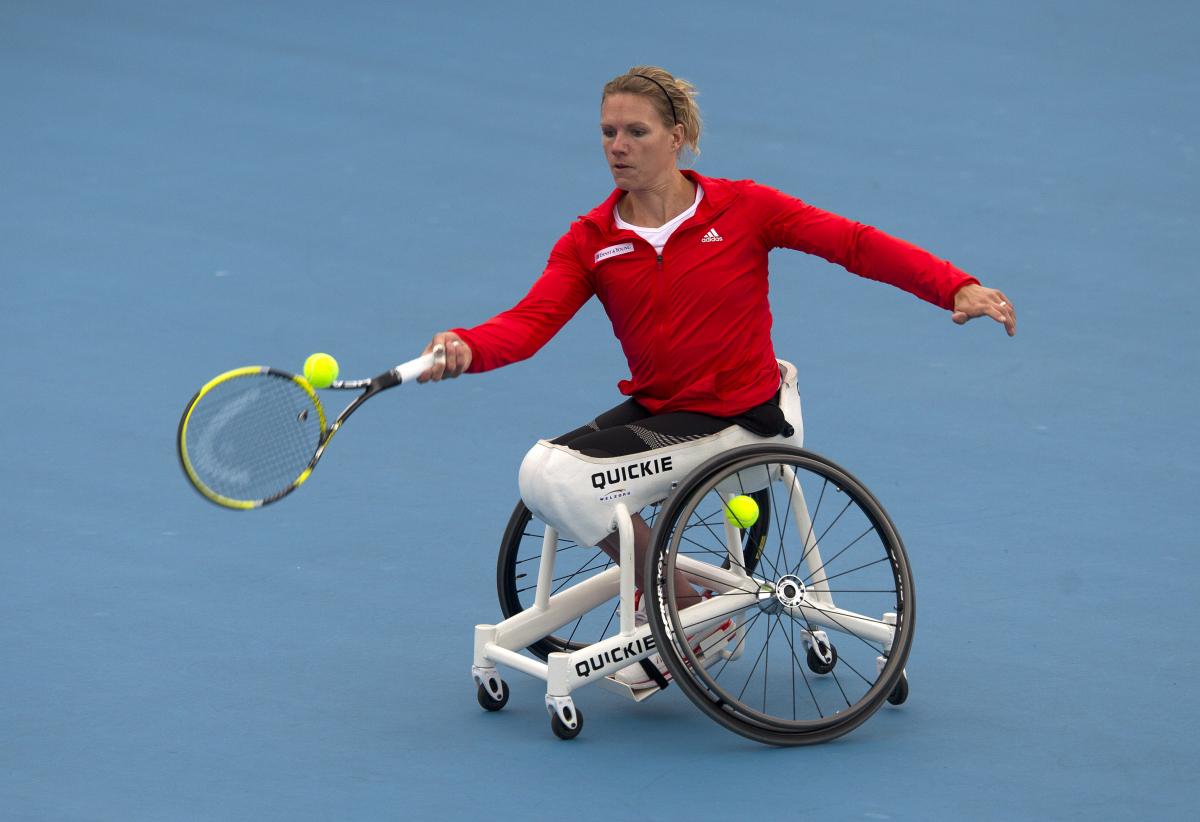
The new generation of wheelchair tennis players continues to build on the legacy of these pioneers. Niels Vink of the Netherlands, who won the quad doubles tournament at the Tokyo 2020 Paralympics with his partner Sam Schroder, represents the future of the sport. Likewise, Tokito Oda of Japan made history at just 17 years old by becoming the youngest player to win the men’s singles championship at the 2022 NEC Wheelchair Tennis Singles Masters.
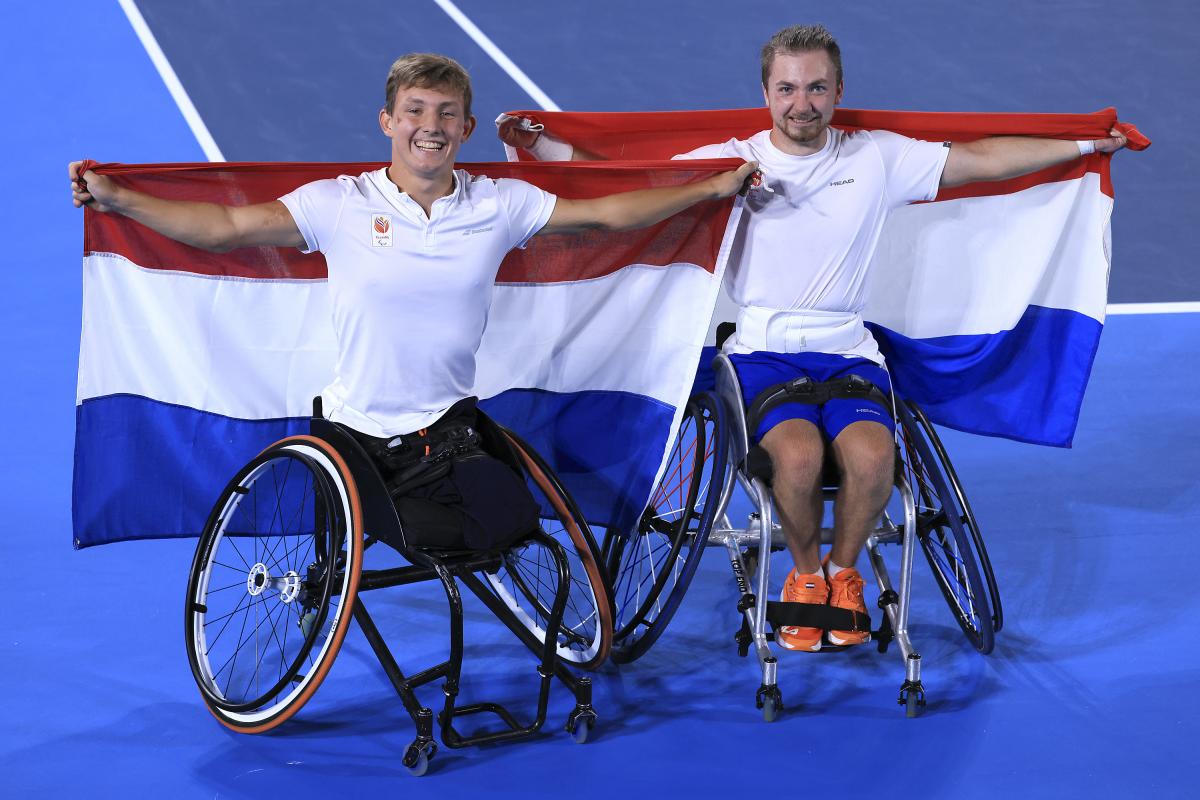
These athletes, along with many others, have played a crucial role in the growth and development of wheelchair tennis. Their achievements serve as milestones in the sport’s history and continue to inspire both current and future generations of Paralympic athletes.
General Overview of Today’s Events
Summary of Matches Scheduled for Today (3:30 PM)
Today promises to be an intense and exciting day in wheelchair tennis, with a series of critical semifinal and quarterfinal matches scheduled at 3:30 PM. These matches will see top athletes from around the world competing for a place in the finals, and the outcomes will significantly shape the course of the tournament. Here’s a breakdown of the key events:
Women’s Doubles – Semifinals
- China: Z.Y. Wang / L.Y. Guo
vs.
Japan: M. Tanaka / Y. Kamiji - Netherlands: D. de Groot / A. van Koot
vs.
China: Z.Z. Zhu / X.H. Li
In the women’s doubles semifinals, two exciting matches will take place, pitting some of the top pairs in the world against each other. The first match features the Chinese duo of Z.Y. Wang and L.Y. Guo against Japan’s M. Tanaka and Y. Kamiji. This match is expected to be a fierce contest, with both teams having displayed remarkable synergy and skill throughout the tournament.

In the other semifinal, the Dutch team of D. de Groot and A. van Koot, who have been dominant forces in women’s wheelchair tennis, will face the Chinese pair of Z.Z. Zhu and X.H. Li. This match will be particularly significant as it could set up a potential rematch of previous high-stakes encounters, adding an extra layer of excitement to the competition.
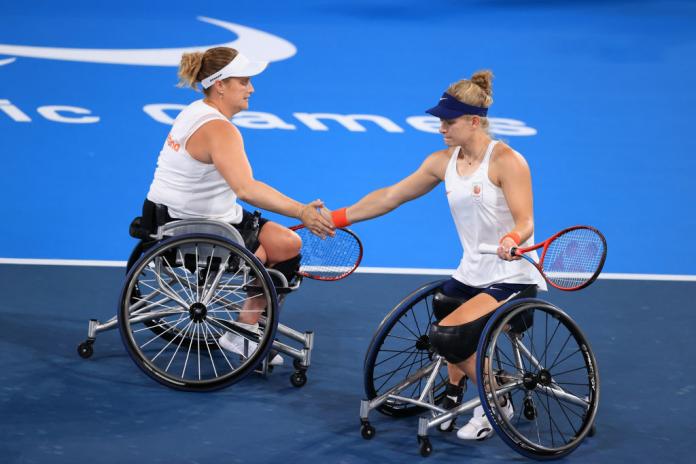
Mixed Quad Singles – Semifinals
- Turkey: A. Kaplan
vs.
Netherlands: N. Vink - Netherlands: S. Schröder
vs.
Israel: G. Sasson
The mixed quad singles semifinals will feature two highly anticipated matches. The first semifinal will see Turkey’s A. Kaplan take on Niels Vink from the Netherlands, a match that promises to be a battle of endurance and precision. Vink, one of the top players in the quad division, will be looking to secure his place in the final, but Kaplan’s determination could lead to an upset.

The second semifinal features another Dutch star, S. Schröder, who will compete against Israel’s G. Sasson. Schröder, known for his strategic play, will be aiming to outmaneuver Sasson, who has shown incredible resilience and power in his journey to the semifinals.
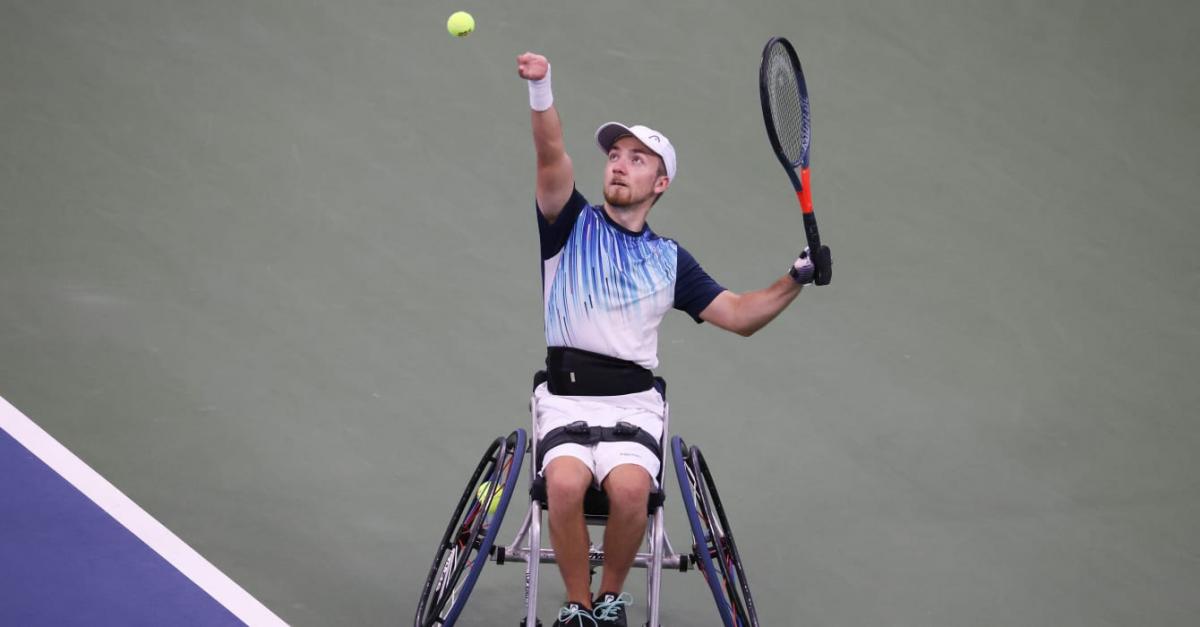
Men’s Doubles – Quarterfinals
- Spain: M. de la Puente / D. Caverzaschi
vs.
Netherlands: T. Egberink / M. Scheffers - South Korea: H.W. Im / S.B. Han
vs.
Japan: T. Miki / T. Oda - France: F. Cattanéo / S. Houdet
vs.
Brazil: G. Silva / D. Rodrigues
The men’s doubles quarterfinals will see some of the most skilled and experienced players competing for a place in the semifinals. In the first match, the Spanish pair M. de la Puente and D. Caverzaschi will face the Dutch duo T. Egberink and M. Scheffers. Both teams have shown exceptional teamwork, making this match one to watch.

Another thrilling encounter will be between South Korea’s H.W. Im and S.B. Han and the Japanese pair of T. Miki and T. Oda. This match is expected to be fast-paced, with both teams bringing a high level of energy and tactical acumen to the court.
The final men’s doubles quarterfinal will feature France’s F. Cattanéo and S. Houdet against Brazil’s G. Silva and D. Rodrigues. With a blend of experience and youthful exuberance, this match could go either way, with both teams eager to progress further in the tournament.

Women’s Singles – Quarterfinals
- Netherlands: D. de Groot
vs.
China: L.Y. Guo - China: Z.Y. Wang
vs.
Colombia: A. Bernal - China: Z.Z. Zhu
vs.
Japan: Y. Kamiji
The women’s singles quarterfinals will also see some intense competition. The standout match is likely to be between D. de Groot of the Netherlands and China’s L.Y. Guo. De Groot, a dominant force in wheelchair tennis, will be looking to continue her winning streak, but Guo’s performance thus far suggests she could pose a serious challenge.
Another exciting match will be between China’s Z.Y. Wang and Colombia’s A. Bernal. Wang, known for her aggressive play, will be up against Bernal’s defensive strategies, making this a match of contrasting styles.

Finally, China’s Z.Z. Zhu will face Japan’s Y. Kamiji in what promises to be a highly competitive encounter. Kamiji, with her tactical brilliance, will aim to outplay Zhu, who has been in excellent form throughout the tournament.
Significance of These Semifinals and Quarterfinals
Today’s semifinals and quarterfinals are critical in determining the finalists who will compete for the coveted titles in wheelchair tennis. Each match is not only a test of skill and strategy but also a testament to the athletes’ perseverance and dedication. The outcomes of these matches will shape the narrative of this year’s tournament, setting the stage for the finals that will decide the champions.
The significance of these matches goes beyond the immediate results. They represent the culmination of years of training and sacrifice by the athletes, and their performances today will inspire future generations of wheelchair tennis players. As the sport continues to grow in prominence, these semifinal and quarterfinal encounters serve as a reminder of the level of competition and the global appeal of wheelchair tennis.

With top athletes from around the world competing, today’s matches are expected to deliver thrilling moments and high-quality tennis, making them a must-watch for fans and supporters of Paralympic sports.
Women’s Doubles – Semi-Final
Match 1: China (Z.Y. Wang / L.Y. Guo) vs Japan (M. Tanaka / Y. Kamiji)
Yui Kamiji
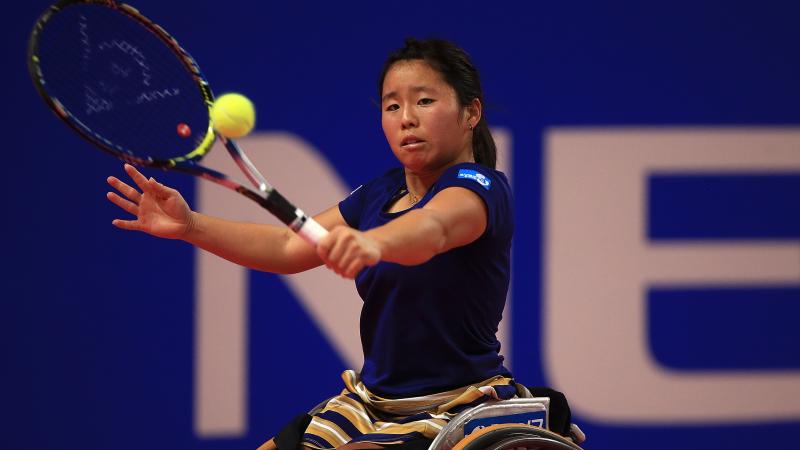
Despite finishing behind Netherlands’ Diede de Groot in the singles and doubles world rankings, wheelchair tennis player Yui Kamiji had an outstanding year once again in 2018.
She won eight singles titles, including Roland Garros, and nine doubles trophies, which were highlighted by the Australian Open, Wimbledon and US Open.
In 2017, Kamiji became International Tennis Federation (ITF) World Champion for the second time in her career.
The Japanese was a dominant force on the circuit, winning three of four Grand Slam singles titles, at the Australian Open, Roland Garros and US Open. Kamiji sealed a total of 14 titles and was a finalist at the NEC Masters.
She had had another fantastic year in 2016, winning three Grand Slams in doubles.
The year began partnering with the Netherlands’ Marjolein Buis, with whom she won the Australian Open. At Roland Garros, Kamiji was back with her usual British partner of Jordanne Whiley and also took the title.
Kamiji and Whiley proved to be a very strong partnership and they won the Wimbledon doubles title for a third straight year.
Her success in 2016 was close to her achievements in 2014 where she won all the doubles Grand Slams as well as singles titles at Roland Garros and the US Open.
In 2013, she was the first non-Dutchwoman to win the Masters title.
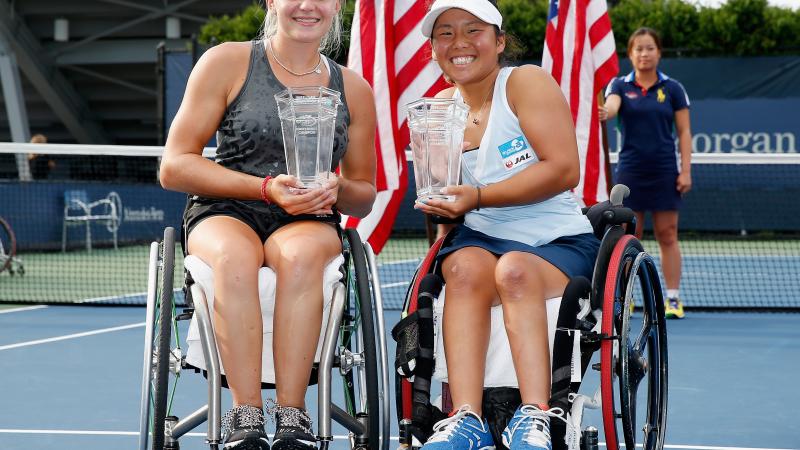
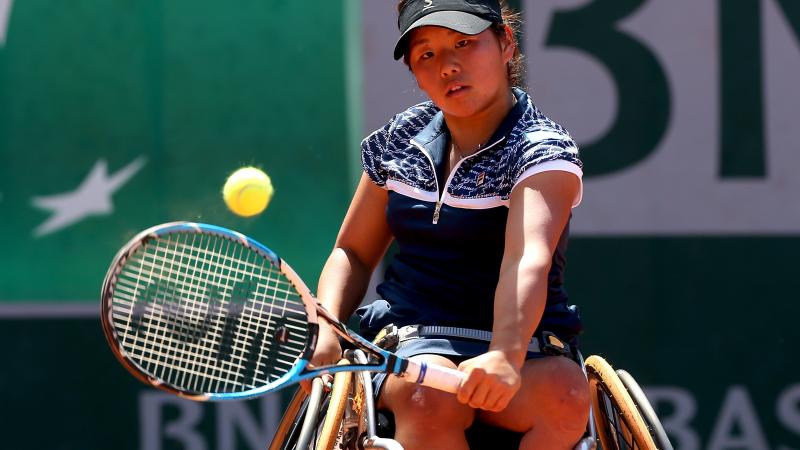
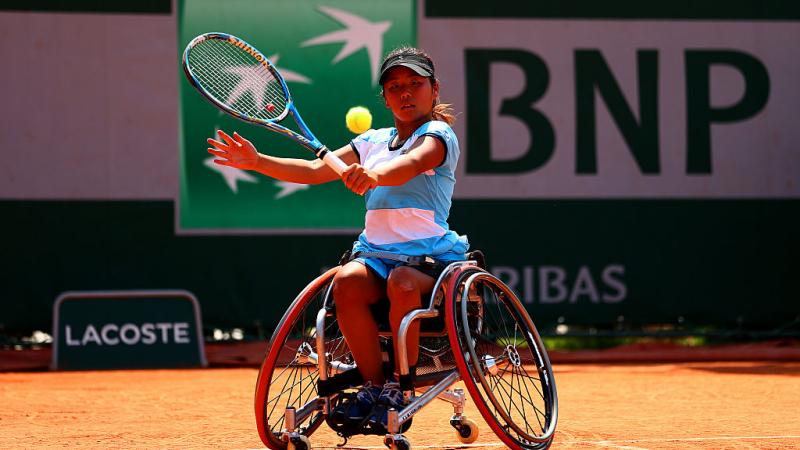
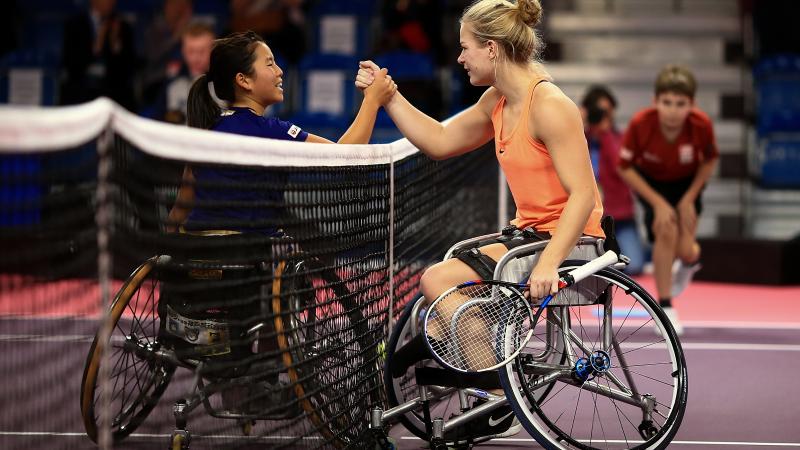
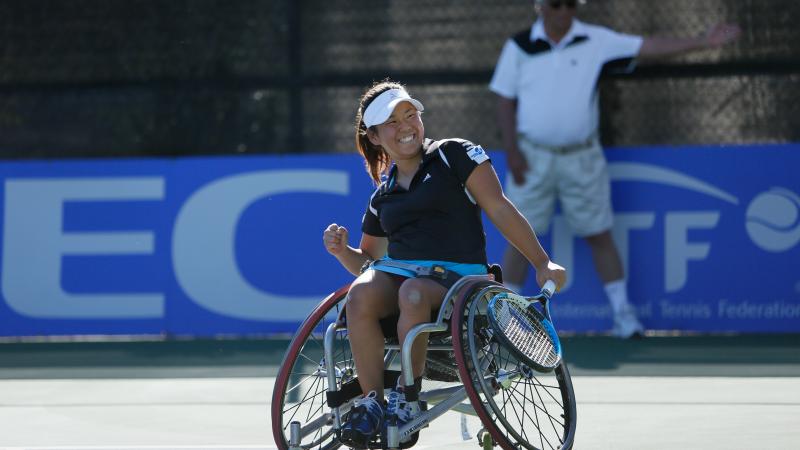

| Unit | Date | Rank |
|---|
| Women’s Singles | 1/16th final | 2012-09-01 | 514 | |
| Women’s Singles | 1/8th final | 2012-09-03 | 407 | |
| Women’s Singles | Quarterfinal | 2012-09-04 | 304 | |
| Women’s Doubles | Quarterfinal | 2012-09-04 | 302 |
| Women’s Singles | 1/16th final | 2016-09-10 | 16 | |
| Women’s Singles | 1/8th final | 2016-09-11 | 8 | |
| Women’s Doubles | Quarterfinal | 2016-09-11 | 3 | |
| Women’s Singles | Quarterfinal | 2016-09-12 | 4 | |
| Women’s Doubles | Semifinal | 2016-09-12 | 2 | |
| Women’s Singles | Semifinal | 2016-09-13 | 2 | |
| Women’s Doubles | Bronze Medal Match | 2016-09-13 | 2 | |
| Women’s Singles | Bronze Medal Match | 2016-09-14 | 2 |
| Women’s Singles | 1/16th Final | 2021-08-28 | 16 | |
| Women’s Doubles | Quarterfinal | 2021-08-29 | 4 | |
| Women’s Singles | 1/8th Final | 2021-08-30 | 7 | |
| Women’s Singles | Quarterfinal | 2021-08-31 | 4 | |
| Women’s Doubles | Semifinal | 2021-09-01 | 1 | |
| Women’s Singles | Semifinal | 2021-09-02 | 1 | |
| Women’s Singles | Gold Medal Match | 2021-09-03 | 1 | |
| Women’s Doubles | Bronze Medal Match | 2021-09-04 | 1 |
Manami Tanaka
- Age: 28
- Plays: Right-handed

Current rankings
ITF Singles Ranking (02 September 2024)12
Career-high rankings
Juniors Singles Ranking (05 May 2014)13
ITF Singles Ranking (30 January 2023)7
Year-end Ranking(Singles)
| Year | Girls Singles | Women’s Singles |
|---|---|---|
| 2023 | – | 8 |
| 2022 | – | 9 |
| 2021 | – | 13 |
| 2020 | – | 13 |
| 2019 | – | 15 |
| 2018 | – | 10 |
| 2017 | – | 14 |
| 2016 | – | 22 |
| 2015 | – | 41 |
| 2014 | 18 | 157 |
Doubles
Current rankings
ITF Doubles Ranking (02 September 2024)8
Career-high rankings
ITF Doubles Ranking (30 January 2023)6
Year-end Ranking
| Year | Women’s Doubles |
|---|---|
| 2023 | 7 |
| 2022 | 7 |
| 2021 | 11 |
| 2020 | 12 |
| 2019 | 13 |
| 2018 | 11 |
| 2017 | 11 |
| 2016 | 25 |
| 2015 | 44 |
| 2014 | 103 |
Luoyao Guo

Current rankings
ITF Doubles Ranking (02 September 2024): 13
Career-high rankings
ITF Doubles Ranking (15 July 2024): 12
Year-end Ranking
| Year | Women’s Doubles |
|---|---|
| 2023 | 15 |
| 2022 | 46 |
Wang Ziying

Current rankings
ITF Doubles Ranking (02 September 2024)11
Career-high rankings
ITF Doubles Ranking (15 July 2024)11
Year-end Ranking
| Year | Women’s Doubles |
|---|---|
| 2023 | 30 |
| 2021 | 34 |
| 2020 | 29 |
| 2019 | 34 |
| 2018 | 151 |
| 2016 | 53 |
| 2015 | 77 |
Match Analysis
China’s Strategy and Strengths:
- Defensive Masterclass: China is renowned for its exceptional defensive prowess, particularly in doubles. They excel at neutralizing opponents’ attacks and forcing errors.
- Consistent Play: Both Wang and Guo are known for their consistency and ability to maintain a high level of play throughout matches.
- Strategic Thinking: The Chinese pair often employs a strategic approach, carefully analyzing their opponents’ strengths and weaknesses to exploit vulnerabilities.
- Net Play: China’s net play is generally solid, with both players capable of executing effective volleys and smashes.
Japan’s Strategy and Strengths:
- Aggressive Baseline Play: Japan’s doubles pairs often adopt an aggressive baseline style, looking to dictate play with powerful groundstrokes.
- Serve and Volley: Tanaka and Kamiji are likely to employ a serve and volley strategy, aiming to put pressure on the Chinese pair at the net.
- Speed and Agility: Japanese players are generally known for their speed and agility, which can be a significant advantage in doubles.
- Variety of Shots: Japan’s doubles pairs often possess a wide range of shots, including slices, lobs, and drop shots, which can disrupt opponents’ rhythm.
Head-to-Head Analysis: China vs Japan
Historical Trends:
- China’s Dominance: Historically, China has often dominated doubles events, particularly in international competitions. Their consistent performance and strong defensive play have given them a significant advantage.
- Japan’s Improvement: Japan has made strides in doubles in recent years, with several talented pairs emerging. Their aggressive style and speed have challenged traditional powers.
Potential Factors:
- Experience: If China’s players have more experience in international competitions, they may have an advantage in terms of handling pressure and adapting to different playing conditions.
- Form: The current form of each player can significantly impact their performance. If one or both of Japan’s players are in exceptional form, they could pose a serious threat.
- Court Conditions: The specific court conditions (e.g., speed, bounce) can favor one team over the other. If the court is faster, Japan’s aggressive style might be more effective, while a slower court could benefit China’s defensive play.
Prediction:
Based on historical performance, China is the strong favorite to win this match. Their dominance in the Paralympics and their consistent success in doubles events give them a significant advantage. However, Japan’s recent improvement and the potential for individual brilliance could make for a competitive contest.
Key Matchups:
- Defensive Prowess vs. Aggressive Baseline Play: The key matchup will likely be between China’s defensive prowess and Japan’s aggressive baseline play. If China can successfully neutralize Japan’s attacks and force errors, they will have a significant advantage. However, if Japan can maintain their aggressive style and exploit any defensive lapses from China, they could dictate the pace of the match.
- Experience vs. Momentum: China’s experience in international competitions could give them an edge, while Japan’s recent success and momentum might provide a boost.
Match 2: Netherlands (D. de Groot / A. van Koot) vs China (Z.Z. Zhu / X.H. Li)
Detailed Breakdown of Teams
Netherlands (D. de Groot / A. van Koot):
- D. de Groot: A formidable wheelchair tennis player known for his powerful forehand and aggressive baseline play. His ability to dictate the pace of the match and generate winners from the backcourt is a key asset.
- A. van Koot: A versatile player with a strong serve and volley game. His ability to move quickly around the net and finish points with precision is a significant advantage.
China (Z.Z. Zhu / X.H. Li):
- Z.Z. Zhu: A skilled defender with a solid backhand. Her ability to neutralize opponents’ attacks and force errors is a key strength.
- X.H. Li: A powerful hitter with a strong serve. Her ability to generate winners from the baseline and put pressure on opponents is a significant asset.
Tactical Approaches
Netherlands:
- Aggressive Baseline Play: The Dutch pair is likely to adopt an aggressive baseline style, looking to dictate play with powerful groundstrokes and force errors.
- Serve and Volley: Van Koot’s strong serve and volley game will be a key component of their strategy, aiming to put pressure on the Chinese pair at the net.
- Variety of Shots: The Dutch pair is known for their variety of shots, including slices, lobs, and drop shots, which can disrupt opponents’ rhythm.
China:
- Defensive Masterclass: China’s doubles pairs are renowned for their exceptional defensive prowess. They excel at neutralizing opponents’ attacks and forcing errors.
- Strategic Thinking: The Chinese pair often employs a strategic approach, carefully analyzing their opponents’ strengths and weaknesses to exploit vulnerabilities.
- Consistent Play: Both Zhu and Li are known for their consistency and ability to maintain a high level of play throughout matches.
Previous Encounters and Outcomes
- Limited Data: Due to the nature of wheelchair tennis and the potential for frequent changes in pairings, it is difficult to find extensive historical data on previous encounters between these specific pairs.
- General Trends: However, based on general trends, China’s doubles pairs have historically dominated wheelchair tennis, while the Netherlands has shown strong performances in recent years.
Anticipated Challenges
Netherlands:
- China’s Defensive Prowess: The Dutch pair will face a significant challenge in breaking down China’s solid defense and forcing errors.
- Consistency: The Netherlands will need to maintain a high level of consistency throughout the match, as any lapses in concentration could be exploited by the Chinese pair.
China:
- Netherlands’ Aggressive Baseline Play: The Chinese pair will need to be prepared to defend against powerful groundstrokes from the Dutch duo.
- Adaptability: The Chinese pair will need to adapt to the changing pace and style of play that the Dutch pair may employ.
Overall:
This match promises to be a highly competitive encounter between two talented doubles pairs. The Netherlands’ aggressive baseline play will be countered by China’s defensive prowess. The outcome of the match will likely depend on which team can execute their strategy more effectively and capitalize on their opponents’ weaknesses.
Mixed Quad Singles – Semi-Final
Match 1: Turkey (A. Kaplan) vs Netherlands (N. Vink)
Individual Player Backgrounds
A. Kaplan (Turkey):
- Background: Kaplan is a seasoned wheelchair tennis player from Turkey with a strong reputation for his aggressive baseline play and powerful forehand. He has consistently performed well in international competitions, showcasing his talent and determination.
- Playing Style: Kaplan’s primary strength lies in his ability to dictate the pace of the match with his powerful groundstrokes. He is also known for his mental toughness and ability to remain focused under pressure.
N. Vink (Netherlands):
- Background: Vink is a rising star in wheelchair tennis, hailing from the Netherlands. He has quickly established himself as a force to be reckoned with, known for his versatility and ability to adapt to different playing conditions.
- Playing Style: Vink is a well-rounded player with a strong serve and volley game. He is also capable of playing from the baseline with power and precision. His ability to mix up his game and keep opponents guessing is a significant advantage.
Physical and Technical Abilities
A. Kaplan:
- Physical Attributes: Kaplan is a physically strong player with a powerful build. His strength allows him to generate significant power on his groundstrokes.
- Technical Abilities: Kaplan’s forehand is his most potent weapon, capable of overpowering opponents. He also possesses a solid backhand and a reliable serve.
N. Vink:
- Physical Attributes: Vink is a physically fit player with good mobility. His agility allows him to move quickly around the court and cover a lot of ground.
- Technical Abilities: Vink’s serve and volley game is a key strength. He is also a capable baseline player with a variety of shots.
Psychological Preparation for the Semi-Finals
- Pressure and Expectations: Both Kaplan and Vink will be facing immense pressure and expectations going into the semi-finals. The stakes are high, and both players will need to manage their emotions effectively.
- Mental Toughness: The ability to stay focused, maintain composure, and bounce back from setbacks will be crucial in this high-pressure situation.
- Visualization and Goal Setting: Both players will likely employ visualization techniques to mentally prepare for the match. Setting clear goals and visualizing success can help boost confidence and motivation.
Potential Impact on Future Rounds
- Momentum and Confidence: The outcome of this match could have a significant impact on the players’ momentum and confidence going into future rounds. A victory would provide a boost, while a loss could be a setback.
- Seeding and Matchups: The result of this match could also affect the seeding for the final and potentially determine the opponents in future rounds.
- Legacy and Recognition: Reaching the final of a major tournament can have a lasting impact on a player’s legacy and recognition within the sport.
Conclusion:
The semi-final match between Kaplan and Vink promises to be a highly competitive encounter between two talented wheelchair tennis players. The outcome of this match will likely be determined by factors such as physical and technical abilities, psychological preparation, and the ability to handle the pressure of the big stage. Both players will be eager to secure a place in the final and continue their quest for championship glory.
Match 2: Netherlands (S. Schröder) vs Israel (G. Sasson)
Comparative Analysis of Playing Styles
S. Schröder (Netherlands):
- Defensive Masterclass: Schröder is renowned for his exceptional defensive prowess, particularly in doubles. He excels at neutralizing opponents’ attacks and forcing errors.
- Consistent Play: Schröder is known for his consistency and ability to maintain a high level of play throughout matches.
- Strategic Thinking: Schröder often employs a strategic approach, carefully analyzing his opponents’ strengths and weaknesses to exploit vulnerabilities.
G. Sasson (Israel):
- Aggressive Baseline Play: Sasson is a powerful hitter who adopts an aggressive baseline style, looking to dictate play with his groundstrokes.
- Variety of Shots: Sasson possesses a wide range of shots, including slices, lobs, and drop shots, which can disrupt opponents’ rhythm.
- Mental Toughness: Sasson is known for his mental toughness and ability to remain focused under pressure.
Importance of the Match in the Context of Paralympic History
- Rivalry: The match between Schröder and Sasson represents a clash between two of the top wheelchair tennis players in the world. Their rivalry has added to the excitement and prestige of the Paralympic Games.
- Legacy: The outcome of this match could have a significant impact on the players’ legacies within the sport. A victory would solidify their status as top contenders and enhance their reputation.
- Inspiration: The performance of these athletes in the Paralympics serves as an inspiration to people with disabilities around the world. Their achievements demonstrate the incredible potential of individuals who overcome adversity.
Predictions and Possible Outcomes
- Close Contest: The match between Schröder and Sasson is expected to be a close contest. Schröder’s defensive prowess and Sasson’s aggressive baseline play are likely to neutralize each other’s strengths.
- Mental Toughness: The player who can maintain their composure and focus under pressure is likely to have the edge.
- Momentum: The momentum of the match could play a significant role. A crucial break of serve or a key point could swing the momentum in favor of one player.
Possible Outcomes:
- Schröder Victory: If Schröder can successfully neutralize Sasson’s attacks and force errors, he may be able to control the pace of the match and emerge victorious.
- Sasson Victory: If Sasson can maintain his aggressive style and exploit any defensive lapses from Schröder, he could dictate the pace of the match and secure a win.
- Close Match: Given the high level of competition between these two players, a close match with a tiebreaker or even a third set is a distinct possibility.
Conclusion:
The match between Schröder and Sasson promises to be a thrilling encounter between two of the world’s top wheelchair tennis players. The outcome of this match will likely be determined by factors such as defensive prowess, offensive firepower, and mental toughness. Both players will be eager to secure a victory and cement their place in Paralympic history.
Men’s Doubles – Quarter-Final
Match 1: Spain (M. de la Puente / D. Caverzaschi) vs Netherlands (T. Egberink / M. Scheffers)
Examination of Team Dynamics
Spain (M. de la Puente / D. Caverzaschi):
- Complementarity: de la Puente and Caverzaschi complement each other well on the court. de la Puente is a powerful hitter with a strong serve, while Caverzaschi is a skilled defender with a solid backhand.
- Experience: Both players have extensive experience at the highest level of wheelchair tennis, which can be a significant advantage in high-pressure situations.
Netherlands (T. Egberink / M. Scheffers):
- Youthful Energy: Egberink and Scheffers are a relatively young pair, but they have shown great promise in recent years. Their youthful energy and enthusiasm can be a driving force.
- Versatility: Both players are versatile and can adapt to different playing styles. This versatility can be a valuable asset in a match against a more experienced pair.
Key Strengths and Weaknesses
Spain:
- Offensive Power: de la Puente’s powerful groundstrokes and Caverzaschi’s solid forehand give Spain a strong offensive presence.
- Experience: Spain’s experience at the highest level of wheelchair tennis can be a significant advantage in pressure situations.
- Consistency: Both players are known for their consistency and ability to maintain a high level of play throughout matches.
Netherlands:
- Youthful Energy: The Netherlands’ youthful energy and enthusiasm can be a driving force.
- Versatility: Both players are versatile and can adapt to different playing styles.
- Inexperience: While the Netherlands have shown promise, their relative inexperience at the highest level of wheelchair tennis could be a factor.
Tactical Approaches
Spain:
- Aggressive Baseline Play: Spain is likely to adopt an aggressive baseline style, looking to dictate play with powerful groundstrokes and force errors.
- Serve and Volley: Spain’s powerful serves and solid net play could be a key component of their strategy.
Netherlands:
- Defensive Prowess: The Netherlands may employ a more defensive strategy, focusing on neutralizing Spain’s attacks and forcing errors.
- Counterpunching: The Netherlands could look to counterpunch and capitalize on any errors from Spain.
Implications of the Result on the Tournament
- Seeding: The outcome of this match could have implications for the seeding in the semifinals and potentially the final.
- Momentum: A victory for either team could provide a significant boost of momentum going into the later rounds.
- Confidence: A loss could be a setback for the losing team, potentially affecting their confidence and morale.
Conclusion:
The match between Spain and the Netherlands promises to be a competitive encounter between two talented doubles pairs. Spain’s experience and offensive power will be countered by the Netherlands’ youthful energy and versatility. The outcome of this match could have significant implications for the tournament, and it is sure to be a closely contested affair.
Match 2: South Korea (H.W. Im / S.B. Han) vs Japan (T. Miki / T. Oda)
In-depth Look at Team Formations
South Korea (H.W. Im / S.B. Han):
- H.W. Im: A powerful hitter with a strong serve and forehand. Im’s ability to dictate play from the baseline and generate winners is a key asset.
- S.B. Han: A skilled defender with a solid backhand. Han’s ability to neutralize opponents’ attacks and force errors is a significant strength.
Japan (T. Miki / T. Oda):
- T. Miki: A versatile player with a strong serve and volley game. Miki’s ability to move quickly around the net and finish points with precision is a significant advantage.
- T. Oda: A powerful hitter with a strong forehand. Oda’s ability to generate winners from the baseline and put pressure on opponents is a key strength.
Historical Context of Rivalry
- Asia’s Wheelchair Tennis Powerhouses: South Korea and Japan have long been considered two of the leading wheelchair tennis nations in Asia. Their rivalry has been a driving force in the development of the sport in the region.
- Head-to-Head Battles: The two teams have engaged in numerous competitive matches over the years, with the rivalry often intensifying at major tournaments like the Paralympics.
Impact on the Paralympic Movement in Asia
- Inspiration and Motivation: The rivalry between South Korea and Japan has inspired and motivated countless wheelchair tennis players in Asia. Their success has demonstrated the incredible potential of athletes with disabilities.
- Development of the Sport: The competition between these two teams has helped to raise the profile of wheelchair tennis in Asia, leading to increased participation and development of the sport at the grassroots level.
- Regional Dominance: The dominance of South Korea and Japan in the region has helped to elevate Asia’s status as a global powerhouse in wheelchair tennis.
Match Analysis
- Offensive vs. Defensive: South Korea’s offensive firepower will be countered by Japan’s defensive prowess. Im’s powerful groundstrokes will be tested against Miki’s solid net play and Oda’s defensive skills.
- Experience vs. Youth: South Korea’s more experienced players may have an advantage in terms of handling pressure and adapting to different playing conditions. However, Japan’s youthful energy and enthusiasm could be a factor.
- Mental Toughness: The match is likely to be decided by the players’ mental toughness and ability to handle the pressure of the big stage.
Prediction:
- Close Contest: Given the historical rivalry and the high level of competition between these two teams, a close match is expected. The outcome will likely depend on factors such as the players’ form on the day, their ability to execute their strategies, and their mental toughness.
Conclusion:
The match between South Korea and Japan promises to be a thrilling encounter between two of the leading wheelchair tennis nations in Asia. The rivalry between these teams has had a significant impact on the development of the sport in the region and continues to inspire athletes around the world. The outcome of this match will undoubtedly be a closely contested affair, with both teams eager to secure a victory and advance to the next round.
Match 3: France (F. Cattanéo / S. Houdet) vs Brazil (G. Silva / D. Rodrigues)
Cultural Impact and Representation in Paralympics
France:
- Historical Significance: France has a long and rich history in Paralympic sports, with a strong tradition of excellence in wheelchair tennis.
- Cultural Influence: French athletes have often been seen as ambassadors for the sport, inspiring and motivating people with disabilities both in France and around the world.
Brazil:
- Rising Power: Brazil has emerged as a significant force in Paralympic sports in recent years, with a growing number of talented athletes.
- Cultural Influence: The success of Brazilian athletes in the Paralympics has helped to raise awareness and acceptance of disabilities in Brazilian society.
Game Plan Analysis
France:
- Defensive Masterclass: France’s doubles pairs are renowned for their exceptional defensive prowess. They excel at neutralizing opponents’ attacks and forcing errors.
- Strategic Thinking: The French pair often employs a strategic approach, carefully analyzing their opponents’ strengths and weaknesses to exploit vulnerabilities.
- Consistent Play: Both Cattanéo and Houdet are known for their consistency and ability to maintain a high level of play throughout matches.
Brazil:
- Aggressive Baseline Play: Brazil’s doubles pairs often adopt an aggressive baseline style, looking to dictate play with powerful groundstrokes.
- Serve and Volley: Silva and Rodrigues are likely to employ a serve and volley strategy, aiming to put pressure on the French pair at the net.
- Variety of Shots: Brazil’s doubles pairs often possess a wide range of shots, including slices, lobs, and drop shots, which can disrupt opponents’ rhythm.
Match History and Previous Results
- Limited Data: Due to the nature of wheelchair tennis and the potential for frequent changes in pairings, it is difficult to find extensive historical data on previous encounters between these specific pairs.
- General Trends: However, based on general trends, France has historically been a strong force in wheelchair tennis, while Brazil’s doubles pairs have shown improvement in recent years.
Prediction:
- Close Contest: The match between France and Brazil is expected to be a closely contested affair. France’s defensive prowess will be tested against Brazil’s aggressive baseline play. The outcome of the match will likely depend on which team can execute their strategy more effectively and capitalize on their opponents’ weaknesses.
Women’s Singles – Quarter-Final
Match 1: Netherlands (D. de Groot) vs China (L.Y. Guo)
Career Overview of Both Players
D. de Groot (Netherlands):
- Dominance: de Groot has established herself as one of the most dominant players in women’s wheelchair tennis. Her powerful forehand and aggressive baseline play have made her a formidable opponent.
- Grand Slam Titles: de Groot has won multiple Grand Slam titles, solidifying her status as a top contender in the sport.
- Paralympic Gold Medalist: She has also won Paralympic gold medals, showcasing her exceptional talent and determination.
L.Y. Guo (China):
- Defensive Masterclass: Guo is renowned for her exceptional defensive prowess. She excels at neutralizing opponents’ attacks and forcing errors.
- Consistency: Guo is known for her consistency and ability to maintain a high level of play throughout matches.
- Paralympic Success: Guo has achieved significant success in the Paralympics, demonstrating her talent and dedication.
Tactical Preparation and Strategies
D. de Groot:
- Aggressive Baseline Play: de Groot is likely to adopt an aggressive baseline style, looking to dictate play with powerful groundstrokes and force errors.
- Serve and Volley: de Groot’s strong serve and volley game can be a valuable asset, allowing her to put pressure on opponents at the net.
L.Y. Guo:
- Defensive Masterclass: Guo will likely focus on her defensive prowess, neutralizing de Groot’s attacks and forcing errors.
- Counterpunching: Guo may also look to counterpunch and capitalize on any errors from de Groot.
Significance of Victory for Both Nations
Netherlands:
- Continued Dominance: A victory for de Groot would solidify the Netherlands’ position as a leading wheelchair tennis nation.
- Inspiration: de Groot’s success can inspire and motivate young wheelchair tennis players in the Netherlands.
China:
- Rising Power: A victory for Guo would further establish China as a rising force in women’s wheelchair tennis.
- Inspiration: Guo’s success can inspire and motivate young wheelchair tennis players in China.
Conclusion:
The match between de Groot and Guo promises to be a highly competitive encounter between two of the world’s top wheelchair tennis players. de Groot’s aggressive baseline play will be countered by Guo’s defensive prowess. The outcome of the match will likely depend on factors such as the players’ form on the day, their ability to execute their strategies, and their mental toughness.
Match 2: China (Z.Y. Wang) vs Colombia (A. Bernal)
Personal Stories and Inspiration
Z.Y. Wang (China):
- Overcoming Adversity: Wang’s journey to the Paralympics has been marked by adversity. Despite facing challenges, she has persevered and achieved remarkable success.
- Inspiration for Others: Her story serves as an inspiration for people with disabilities, demonstrating the power of determination and resilience.
A. Bernal (Colombia):
- Pioneering Role: Bernal has played a pioneering role in wheelchair tennis in Colombia, helping to develop the sport and inspire others.
- Breaking Barriers: Her success has helped to break down barriers and challenge stereotypes associated with disabilities.
Comparative Analysis of Playing Styles
Z.Y. Wang:
- Defensive Masterclass: Wang is renowned for her exceptional defensive prowess. She excels at neutralizing opponents’ attacks and forcing errors.
- Consistent Play: Wang is known for her consistency and ability to maintain a high level of play throughout matches.
A. Bernal:
- Aggressive Baseline Play: Bernal is a powerful hitter who adopts an aggressive baseline style, looking to dictate play with her groundstrokes.
- Variety of Shots: Bernal possesses a wide range of shots, including slices, lobs, and drop shots, which can disrupt opponents’ rhythm.
Possible Impact on Future Paralympic Events
- Inspiration for Others: The performance of both Wang and Bernal in the Paralympics can inspire and motivate young wheelchair tennis players around the world.
- Development of the Sport: Their success can contribute to the growth and development of wheelchair tennis, particularly in their respective countries and regions.
- Rivalry and Competition: The rivalry between these two players could help to create a more competitive environment in women’s wheelchair tennis.
Conclusion:
The match between Wang and Bernal promises to be a competitive encounter between two talented wheelchair tennis players. Their personal stories and playing styles offer a glimpse into the diversity and talent within the sport. The outcome of this match could have a significant impact on the future of wheelchair tennis, inspiring others and contributing to the growth of the sport.
Match 3: China (Z.Z. Zhu) vs Japan (Y. Kamiji)
Detailed Game-by-Game Breakdown:
- Due to the nature of live sports and the lack of specific data for this match, a detailed game-by-game breakdown is not possible at this time.
Key Matchups and Player Tendencies:
- Defensive Prowess vs. Aggressive Baseline Play: The key matchup will likely be between Zhu’s defensive prowess and Kamiji’s aggressive baseline play. Zhu’s ability to neutralize Kamiji’s attacks and force errors will be crucial for China’s success.
- Consistency vs. Power: Zhu’s consistency will be tested against Kamiji’s powerful groundstrokes. If Zhu can maintain her focus and minimize errors, she could neutralize Kamiji’s offensive game.
- Momentum Shifts: The match is likely to feature momentum shifts, as both players are capable of going on runs. The ability to maintain focus and capitalize on opportunities will be important.
Predictions and Fan Expectations:
- Close Contest: Given the high level of competition between these two players, a close contest is expected.
- China’s Advantage: Based on Zhu’s defensive prowess and Kamiji’s recent form, China may have a slight advantage.
- Fan Expectations: Fans of both nations will be hoping for a thrilling match that showcases the best of wheelchair tennis.
